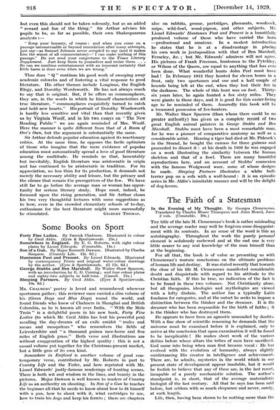Some Books on Sport
Forty Fine Ladies. By Patrick Chalmers. Illustrated in colour by Cecil Aldin. (Eyre & Spottiswoode. 25s.)
Somewhere In England. By E. G. Roberts, with eight colour plates by Lionel Edwards. (Constable. 14s.) Huntsmen Past and Present. By Lionel Edwards. Illustrated by contemporary Prints and original water-colour drawings by the author. (Eyre & Spottiswoode. £2 12s. 6d.) George Stubbs and Ben Marshall. By Walter Shaw Sparrow, with an introduction by E. D. Cuming ; and four colour plates and eighty-two subjects in half-tone. (Cassell. 21s.)
MR. CHALMERS' poetry is loved and remembered wherever sportsmen gather; this reviewer once carried a slim volume of his (Green Days and Blue Days) round the world; and found friends who knew of Chalmers in Shanghai and British Columbia, as he is known all over India. " With the Mule Train " is a delightful poem in his new book, Forty Pine Ladies (to which Mr. Cecil Aldin has lent his powerful pen) recalling the day-dreams of an exile amidst "mules and mesas and mosquitoes " who remembers the fields of Leicestershire and " a thousand guinea race-horse and five miles of English grass." BOth verse and illustrations are without exaggeration of the highest quality : this' is not a casual volume put together for the Christmas-present market, but a little gem of its own kind.
Somewhere in England is another volume of good con- temporary verse, Contributed by Mr. -Roberts in -part to Country Life and the Tatter, and "here reprinted with Mr. Lionel Edwards' justly-famous" renderings of hunting 'scenes. There is both wit and wisdom in the -lines:, and beauty in "the pictures. Major Daieson is well known to readers of Country Life as an authority on shooting:: In-Son of a Gun he teaches the beginner all that" he needs to lmoir about hOw to fit himself with a gun, how to shoot with it, what 'cartridges to use, how to train his dogs and keep his ferrets ; there are chapters also on rabbits, grouse, partridges, pheasants, woodcock, snipe, wild-fowl, wood-pigeon, and other. subjects. Mr. Lionel Edwards' Huntsmen Past and Present is a beautifully produced volume of those who have carried the horn —professional and amateur. In a modest introduction he states that he is at a disadvantage in placing his own work in juxtaposition with that of Ben Marshall, Ferneley, &c. ; but Mr. Edwards' admirers will not agree. His pictures of Frank Freeman, huntsman to the Pytchley, or Wilson of the Quorn, are equal to anything that has ever been done. What wonderful hunts John Peel must have had ! In February 1812 they hunted for eleven hours in a frost, only two sportsmen and one and a half couple of hounds being left at the end, when they lost their fox' in the darkness. The whole of this hunt was on foot. Thirty- six years later, he again hunted a fox sixty miles. They were giants in those days, and it is good for this easier-living age to be reminded of them. Assuredly this book will be a treasured possession of fox-hunters.
Mr. Walter Shaw Sparrow (than whom there could be no greater authority) has given us a complete record of two great English animal painters in George Stubbs and Ben Marshall. Stubbs must have been a most remarkable man, for he was a pioneer of comparatiye anatomy as well as a considerable artist. Hearing a tiger had died at Mr. Pidcock's in the Strand, he bought the carcass for three guineas and proceeded to dissect it : at-his death in 1806 he was engaged on a work illustrating the similarity between the human skeleton and that of a fowl. There are many beautiful reproductions here, and an account of Stubbs' connexion with the famous Wedgwood ware, some of whose designs he made. Sleeping Partners illustrates a white bull- terrier pup on a sofa with a wolf-hound : it is an episodic series in Mr. Aldin's inimitable manner and will be the delight of dog-lovers.












































 Previous page
Previous page